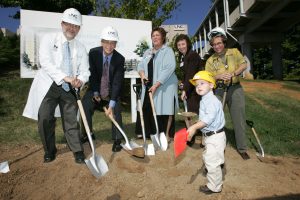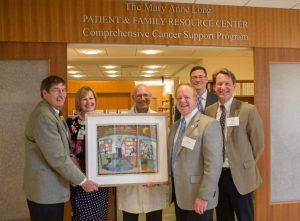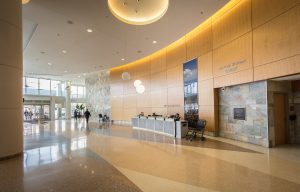This fall marks 10 years since the opening of the North Carolina Cancer Hospital, a state-of-the-art cancer center built by the people of North Carolina for the people.

The state’s investment was designed to substantially improve patient care for the citizens of North Carolina, stimulate cancer research, and impact the state’s economy and position as a national leader in the next evolution of cancer care. With a commitment of $180 million from the state for the hospital and an adjacent office building, state, local and health leaders launched construction as they faced a growing population of cancer patients in the state, and an existing facility that was overcrowded and inadequate for the delivery of modern cancer care.
The new hospital, with its more than 320,000 square feet of space, offered multidisciplinary clinic space, facilities for tumor assessment imaging and treatment, amenities for patient support, and a healing environment, among other features.
It replaced the Gravely Building, which was originally built in the 1950s as a tuberculosis sanatorium. In addition to being gloomy and dark – some referred to it as a dungeon – the facility was too small for the growing number of cancer patients being treated by UNC Cancer Care. The chemotherapy infusion areas and the outpatient clinic areas were overcrowded, there was poor patient flow, and the inpatient care areas were fragmented.
“The biggest benefit of the new hospital was giving the people of North Carolina a cancer hospital that valued them, their time, and their experience,” said Lisa A. Carey, MD, FASCO, the Richardson and Marilyn Jacobs Preyer Distinguished Professor in Breast Cancer Research in the UNC School of Medicine Division of Hematology/Oncology.
A focus on comprehensive cancer care
Carey knew a new facility was needed on her first day in January 1998, she said. The infusion center moved consistently as patient volumes grew.
“People were amazingly kind about it – both doctors and patients – but the beautiful new infusion center was such a relief,” she said.
Still, Carey said people who worked there were the best thing about the old facility – and that’s still true.
Joel E. Tepper, MD, the Hector MacLean Distinguished Professor of Cancer Research in the UNC School of Medicine Department of Radiation Oncology, said the new hospital provided a focus for all of the different aspects of a comprehensive cancer program, including patient support and education, easy access to radiation oncology, and other services.

Jonathan Serody, MD, the Elizabeth Thomas Professor of Medicine, Microbiology and Immunology in the UNC School of Medicine Division of Hematology/Oncology, also highlighted the importance of the hospital as a focal point for cancer care.“The ability to provide all of these activities under one roof is what made the construction of the N.C. Cancer Hospital a transformative event for the hospital and for our patients,” he said.
“The best thing about the cancer hospital initially was the ability to have most of the cancer-specific needs in one building,” he said. “It’s a huge help to have radiology, clinics, the infusion facility and the inpatient beds in one area.”
A healing environment
Mary Beck, the former senior vice president of planning and program development for UNC Health Care, worked behind the scenes to bring the new facility to life along with other leaders and collaborators including Melvin S. Hurston, senior vice president of professional and support services at UNC Health Care.
As a breast cancer survivor who was treated the Gravely Building clinic, she saw the transformation from both an administrative and a patient’s lens.
Beck was diagnosed with an aggressive breast cancer in 1996, and received surgery, radiation at UNC. She also participated in a clinical trial for a new treatment regimen of high-dose chemotherapy. Twenty-three years later, she’s healthy and well.
It was “remarkable” that in the overcrowded Gravely building, staff continued to be upbeat and positive, Beck said. But she realized that the physical facilities weren’t keeping up with advances in care.
Beck said providing a wonderful patient experience, starting from walking in the front door, shaped the new hospital’s design.
“When we were planning and designing the cancer hospital, we wanted it to have lots of light – as much natural light as we could,” Beck said. “We wanted to use materials that were resilient, that felt good and were positive. We wanted to have artwork that supported the feeling of healing and the positive nature that we wanted people to feel when they came in the building.”
When Beck returns to the cancer hospital now, she feels uplifted.

“When I walk into the hospital, I feel assured that the people who work in that building know what they’re doing, care about their patients, care about the patient experience, and want to help you get better,” she said.
And while Beck said they tried to build in as much flexibility into the design, she said she knows that change will be a constant.
“I expect cancer care and therapy to change, I expect for the science that comes out of UNC Lineberger to be cutting edge,” she said. “I expect UNC to continue to be a leader in the state and the country, trying to make people’s lives better for the care they receive. I expect constant enhancements in every part of the model – research, patient care – the patient experience, the staff experience. I expect that to continue well into the future. That’s the only way we make progress.”
To learn about the history of the hospital and to read reflections from patients and doctors, go to our 10-year anniversary website https://unclineberger.org/10-years/.
